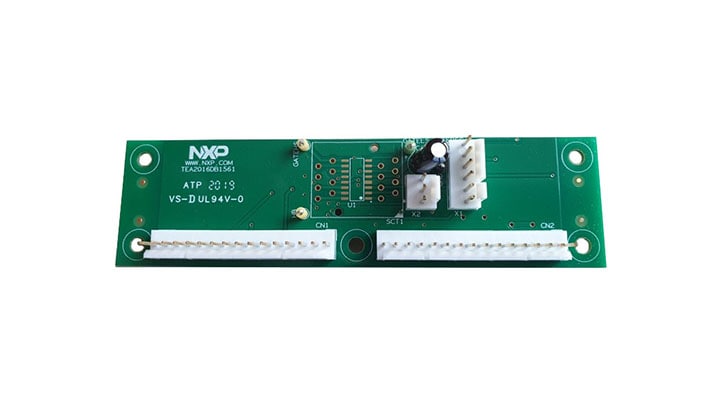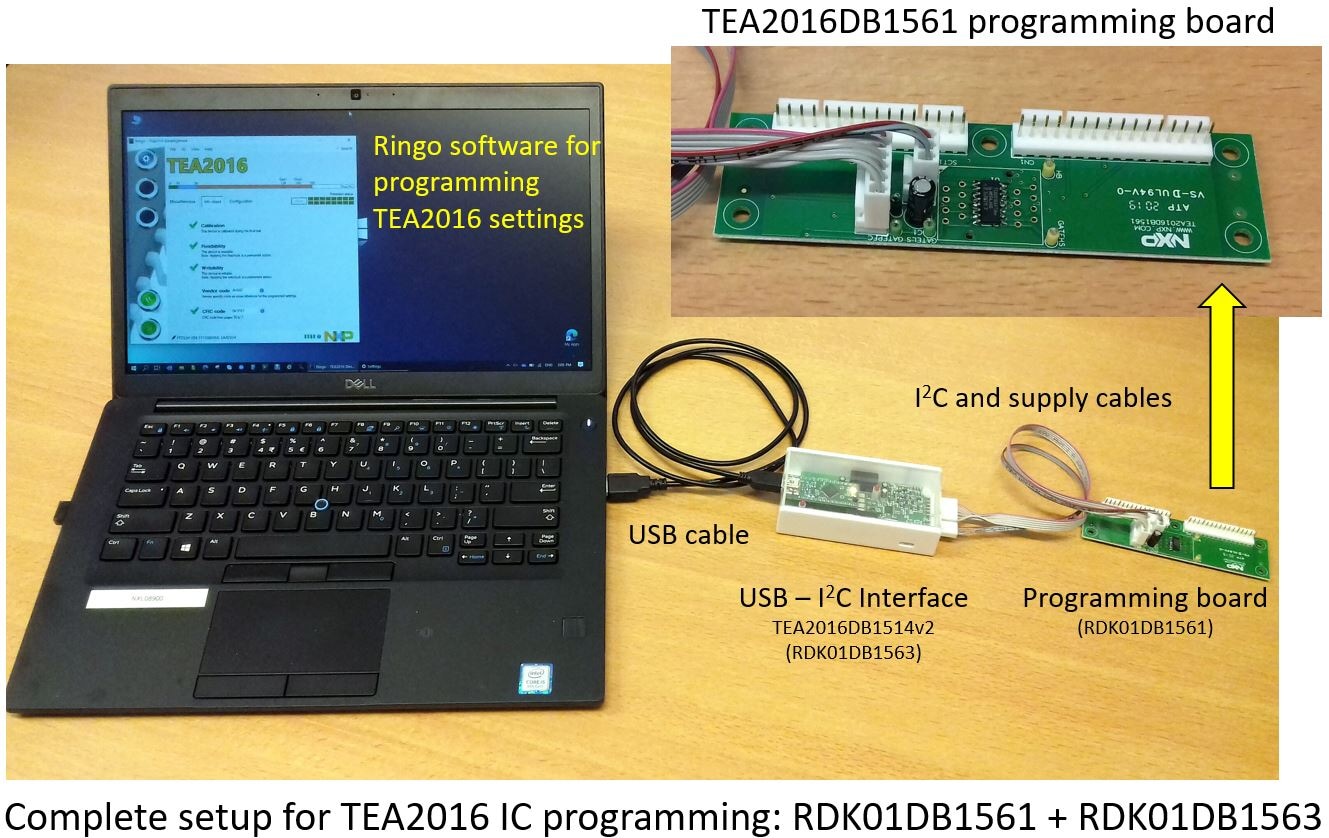Getting Started with the RDK01DB1561
Contents of this document
-
Out of the Box
-
Get Hardware
-
Install Software
-
Configure Hardware
Sign in to save your progress. Don't have an account? Create one.

Purchase your RDK01DB1561: TEA2016AAT Development Programming Board and Samples
1. Out of the Box
The NXP analog product development boards provide an easy-to-use platform for evaluating NXP products. The boards support a range of analog, mixed-signal and power solutions. They incorporate monolithic integrated circuits and system-in-package devices that use proven high-volume technology. NXP products offer a smaller form factor, reduced component counts, lower cost and improved performance in powering state-ofthe- art systems.
This page will guide you through the process of setting up and using the RDK01DB1561 programming board.
1.1 Kit Contents/packing List
The RDK01DB1561 contents include:
- Assembled and tested programming board
- 50 pieces TEA2016AATdev IC samples
1.2 Additional Hardware
In addition to the kit contents, the following hardware is necessary or beneficial when working with this kit.
- Interface TEA2016DB1514v2 (USB-I2C interface board) from the RDK01DB1562 or RDK01DB1563 kit to connect the programming board to a PC
- Windows PC and USB for parameter modifications via software and interface
1.3 Windows PC Workstation
- PC with Windows. Software tested for Windows 7 and Windows 10 but also works on XP, Vista and W8
- 64-bit and 32-bit versions of Ringo software available for download
1.4 Software
Software is necessary to work with this evaluation board. All listed software is available on the evaluation board's information page at TEA2016DB1561.
The Ringo software package contains documents, videos and tools.

2.Get Hardware
2.1 Board Description
This board can be used to get familiar with programming TEA2016AATdev samples. A sample can be soldered to the board for this purpose.
Adding an IC socket (not included) makes the programming board suitable for programming small series of ICs. By connecting both 3-pin and 6-pin cables, TEA2016AAT and TEA2016AAT dev samples can be programmed by selecting the correct channel by the switch on the USB-I2C interface.
2.2 Board Components
Overview of the RDK01DB1561 programming board


3. Install Software
Copy the zip file from the USB stick or download it to a folder on your computer. The x64 is for 64-bit operating systems; the x86 is for 32-bit operating systems. Unzip the file.

For the Ringo software to work, the FT232H driver for the USB-I2C interface needs to be installed. This installation happens automatically when you connect the interface for the first time via USB. If the driver is not installed automatically, you can use the included drivers to do this manually (a video on the get started page shows how to do this).
The Ringo software will not work when the FT232H driver is not installed.
The Ringo program needs no installation. It can be started by double-clicking on Ringo.exe. Keep the other files and folders in the same directory because Ringo makes use of it.
3.1 User Manual and Tutorial Videos For The Ringo Software
A user manual and videos are included in the Ringo GUI software for easy access to get familiar with using the software and getting to know the functions that are available.

Videos are available in Ringo for viewing on your local video player or via the NXP website in your browser:
- Introduction
- Read and write
- Information and protection
- Save settings in file
- Warning and power bar
- Read write lock and reset
- Search and connection quality
Additional videos are available at TEA2016AAT: Digital Controller for High-Efficiency Resonant Power Supply
4. Configure Hardware
4.1 Configure Hardware
A video on the get started page shows how to connect a setup to your computer by USB.
For connecting the programming board to your computer also the interface TEA2016DB1514v2 from RDK01DB1562 or RDK01DB1563 is required.
Connecting a TEA2016DB1561 with a 6-pin cable provides reading or programming TEA2016AAT ICs. Also connect the 3-pin cable if a TEA2016AATdev IC version is used.
The switch on the interface selects the 3-pin or 6-pin connection.

Design Resources
Additional Resources
Product Summary Page
- The product summary page for TEA2016AAT is available at TEA2016AAT.
Tool Summary Page
The tool summary page for RDK01DB1561 board is at RDK01DB1561.
The page provides overview information, technical and functional specifications, ordering information, documentation and software. The Get Started guide provides quick-reference information applicable to using the DK01DB1561 board, including the downloadable assets.
References
In addition to our TEA2016AAT: Digital LLC+PFC Combo Controller for Resonant Power Supply, you may also want to visit:
Application pages:
Hardware pages:
Software pages:
Support
FAQ on Getting Started
Ringo Software
Q: Ringo.exe does not start.
- A1: The USB-I2C interface driver (FT232) needs to be installed on the computer to enable Ringo software to work.
- A2: Make sure you are using a compatible version: 32bit or 64bit.
- A3: Ringo is made for Windows operating systems. On other operating systems, you can run it via a windows emulator.
Q: Can I work with Ringo without the interface connected?
- A1: Yes, when the USB-I2C interface driver (FT232) is already installed.
- A2: To get started the USB-I2C interface driver (FT232) needs to be installed on the computer to enable Ringo software to work. For this the interface needs to be connected (one time) to install the driver.
Q: When I connect the USB-I2C interface, it does not work.
- A1: A driver is needed to make the FT323 module operational. The driver is often automatically installed (plug and play) but sometimes a manual install is required. Several drivers are included in the Ringo zip package. Watch the video “installing USB driver manually” on the NXP website.
- A2: When you installed the driver and still it does not work: completely ('delete the driver software for this device') remove the driver and select another driver included or visit the FTDI chip website for more information or driver versions.
USB - I2C Interface
Q: There is no communication with the IC
- A1: Check if the switch on the interface is in the correct position: 3-pin or 6-pin.
- A2: Check if the correct cable is connected (or both when using the programming board).
- A3: Check if signal disturbance is blocking communication.
Q: I want to make a modification or repair on the board. Is there a circuit diagram?
- The circuit diagram is included in User Manual UM11235. This document is available in the document folder on the USB stick or in the help tab of Ringo.
Q: What is the function of the LEDs on the board?
- A1: The Ringo software can use them for indicating that the I2C connection is OK. The indication differs between Ringo versions. In general, slow blinking indicates no communication with the IC. The fast blinking indicates correct communication with the IC.
Programming Board
Q: Which cable do I need to connect when I want to work with the programming board?
- A1: connect both 3 pin and 6-pin cables and select the correct I2C channel for communication.
- A2: For a TEA2016AAT IC only the 6-pin cable connection is required.
- A3: For a TEA2016AATdev IC, both 3 pin and 6-pin cables are required.
Q: I want to add an IC socket on the board. What is a suitable type?
- A1: Provisions in the board are for a Wells CTI 652B0162215 SO16 socket.
Q: I want to measure signals or make a modification on the board. Is there a circuit diagram?
- A1: The circuit diagram is included in Ringo or available for download.
RDK01DB1561 Kit
Q: Can I also work with TEA2016AATdev without buying an extra kit?
- A1: Yes, you can use the TEA2016 IC in a power supply as with other IC types. In this case, you make use of the IC standard parameter settings.
- A2: When you want to make use of modifying TEA2016 settings for optimizing your design, you need the software and an interface board.